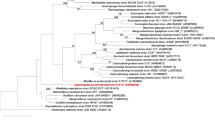Abstract
A motile curved rod-shaped bacterium was isolated in pure culture from a glycolate-fermenting mixed culture by using citrate as the growth substrate. The purified strain, designated 19gly1, was an obligate anaerobe growing optimally in freshwater medium at neutral pH and 37°C. The organism was gram-negative, lacked cytochromes, and had a DNA mol % G+C ratio of 36. Strain 19gly1 grew on only a limited range of substrates, including citrate and succinate. No growth occurred on glycolate, on carbohydrates or on H2 plus CO2. Metabolism was by fermentation only. The strain was different to previously described species of bacteria and assigned to the heterogeneous assemblage of “Campylobacter-like” strains. Strain 19gly1 has been deposited with the Deutsche Sammlung von Mikroorganismen as DSM 6222.
Similar content being viewed by others
References
Barik S, Brulla WJ, Bryant MP (1985) PA-1, a versatile anaerobe obtained in pure culture, catabolizes benzenoids and other compounds in syntrophy with hydrogenotrophs, and P-2 plus Wolinella sp. degrades benzenoids. Appl Environ Microbiol 50:304–310
Breznak JA, Switzer JM, Seitz HJ (1988) Sporomusa termitida sp. nov., and H2/CO2-utilizing acetogen isolated from termites. Arch Microbiol 150:282–288
Brulla WJ, Bryant MP (1989) Growth of the syntrophic acetogen, strain PA-1, with glucose or succinate as energy source. Appl Environ Microbiol 55:1289–1290
Carlone GM, Valadez MJ, Pickett MJ (1983) Methods for distinguishing gram-positive from gram-negative bacteria. J Clin Microbiol 16:1157–1159
Cerny G (1978) Studies on the aminopeptidase test for the distinction of gram-negative from gram-positive bacteria. Eur J Appl Microbiol Biotechnol 5:113–122
Dehnig I, Stieb M, Schink B (1989) Sporomusa malonica sp. nov., a homoacetogenic bacterium growing by decarboxylation of malonate or succinate. Arch Microbiol 151:421–426
Denger K, Schink B (1990) New motile anaerobic bacteria growing by succinate decarboxylation to propionate. Arch Microbiol 154:550–555
Dimroth P (1982) The generation of an electrochemical gradient of sodium ions upon decarboxylation of oxaloacetate by the membrane bound and Na+-activated oxaloacetate decarboxylase from Klebsiella aerogenes. Eur J Biochem 121:443–449
Goodwin CS, Armstrong JA, Chilvers T, Peters M, Collins MD, Sly L, McConnell W, Harper WES (1989) Transfer of Campylobacter pylori and Campylobacter mustelae to Heliobacter gen. nov. as Helicobacter pylori comb. nov. and Helicobacter mustelae comb. nov., respectively. Int J Syst Bacteriol 39:397–405
Hermann M, Popoff MR, Sebald M (1987) Sporomusa paucivorans sp. nov., a methylotrophic bacterium that forms acetic acid from hydrogen and carbon dioxide. Int J Syst Bacteriol 37:93–101
Holdeman LV, Kelley RW, Moore WEC (1984) Bacteroidaceae. In: Krieg NR, Holt JG (eds) Bergey's manual of systematic bacteriology, vol 1. Williams and Wilkins, Baltimore, pp 602–662
Janssen PH (1990) Fermentation of glycollate by a mixed culture of anaerobic bacteria. Syst Appl Microbiol 13:327–332
Janssen PH, Harfoot CG (1990a) Ilyobacter delafieldii sp. nov., a metabolically restricted anaerobic bacterium fermenting PHB. Arch Microbiol 154:253–259
Janssen PH, Harfoot CG (1990b) Isolation of a Citrobacter species able to grow on malonate under strictly anaerobic conditions. J Gen Microbiol 136:1037–1042
Lannbroek HJ, Kingma W, Veldkamp H (1977) Isolation of an aspartate-fermenting, free-living Campylobacter species. FEMS Microbiol Lett 1:99–102
Möller B, Ossmer R, Howard BH, Gottschalk G, Hippe H (1984) Sporomusa, a new genus of Gram-negative anaerobic bacteria including Sporomusa sphaeroides spec. nov. and Sporomusa ovata spec. nov. Arch Microbiol 139:388–396
Nanninga HJ, Drent WJ, Gottschal JC (1987) Fermentation of glutamate by Selenomonas acidaminophila sp. nov. Arch Microbiol 147:152–157
Norris JR, Berkeley RCW, Logan NA, O'Donnell AG (1981) The genera Bacillus and Sporolactobacillus. In: Starr MP, Stolp H, Trüper HG, Balows A, Schlegel HG (eds) The prokaryotes. A handbook on habitats, isolation an identification of bacteria, vol. 2. Springer, Berlin Heidelberg New York, pp 1711–1742
O'Brien RW, Stern JR (1969) Requirement for sodium in the anaerobic growth of Aerobacter aerogenes on citrate. J Bacteriol 98:388–393
Ollivier B, Cord-Ruwisch R, Lombardo A, Garcia JL (1985) Isolation and characterization of Sporomusa acidovorans sp. nov., a methylotrophic homoacetogenic bacterium. Arch Microbiol 142:307–310
Paster BJ, Dewhirst FE (1988) Phylogeny of campylobacters, wolinellas, Bacteroides gracilis, and Bacteroides ureolyticus by 16S ribosomal ribounucleic acid sequencing. Int J Syst Bacteriol 38:56–62
Schauder R, Schink B (1989) Anaerovibrio glycerini sp. nov., an anaerobic bacterium fermenting glycerol to propionate, cell matter, and hydrogen. Arch Microbiol 152:473–478
Schink B, Pfennig N (1982) Propionigenium modestum gen. nov. sp. nov., a new strictly anaerobic, nonsporing bacterium growing on succinate. Arch Microbiol 133:209–216
Schink B, Thompson TE, Zeikus JG (1982) Characterization of Propionispira arboris gen. nov. sp. nov., a nitrogen-fixing anaerobe common to wetwoods of living trees. J Gen Microbiol 128:2771–2779
Simbert RM (1984) Campylobacter. In: Kreig NR, Holt JG (eds) Bergey's manual of systematic bacteriology, vol 1. Williams and Wilkins, Baltimore, pp 111–118
Stouthamer AH (1979) The search for correlation between theoretical and experimental growth yields. In: Quayle JR (ed) International review of biochemistry, vol 21. Microbial biochemistry. Unversity Park Press, Baltimore, pp 1–47
Tanaka B, Nakamura K, Mikami E (1990) Fermentation of maleate by a gram-negative strictly anaerobic non-sporeformer, Propionivibrio dicarboxylicus gen. nov., sp. nov. Arch Microbiol 154:323–328
Thauer RK, Jungermann K, Decker K (1977) Energy conservation in chemotrophic anaerobic bacteria. Bacteriol Rev 41:100–180
Tschech A, Schink B (1985) Fermentative degradation of resorcinol and resorcylic acids. Arch Microbiol 143:52–59
Wolfe RS, Pfennig N (1977) Reduction of sulfur by spirillum 5175 and syntrophism with Chlorobium. Appl Environ Microbiol 33:427–433
Author information
Authors and Affiliations
Rights and permissions
About this article
Cite this article
Janssen, P.H. Characterization of a succinate-fermenting anaerobic bacterium isolated from a glycolate-degrading mixed culture. Arch. Microbiol. 155, 288–293 (1991). https://doi.org/10.1007/BF00252214
Received:
Accepted:
Issue Date:
DOI: https://doi.org/10.1007/BF00252214




